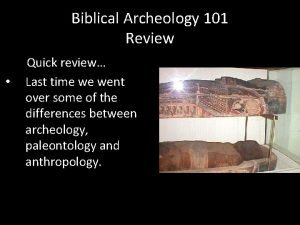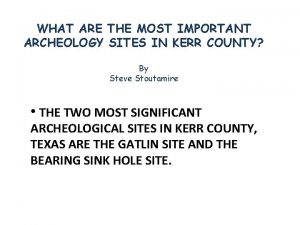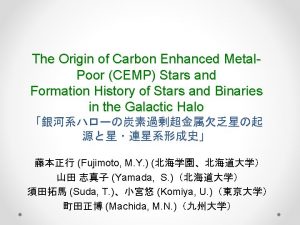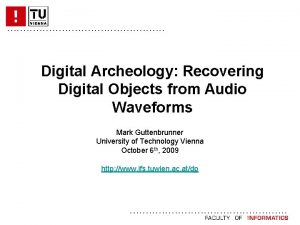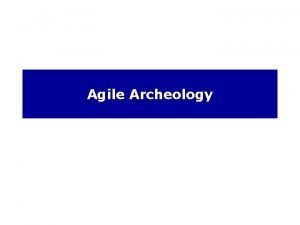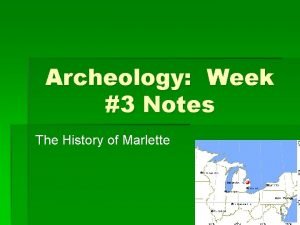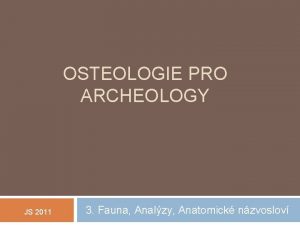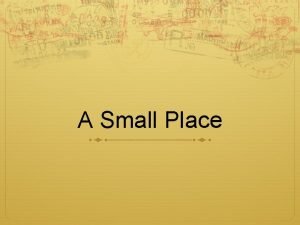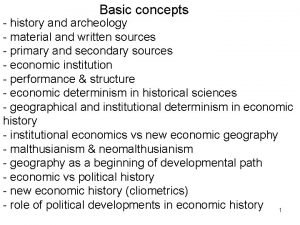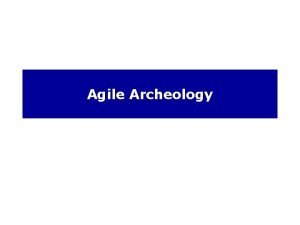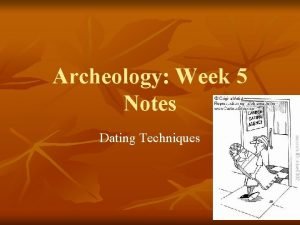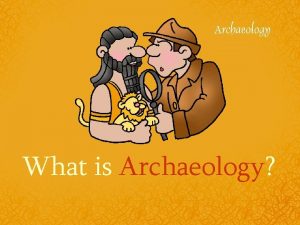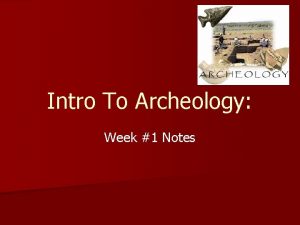Introduction to Archeology What is Archeology n The



















- Slides: 19

Introduction to Archeology

What is Archeology? n The study of the ancient and recent human past through material remains. n In other words…. studying people and civilizations in history by looking at what they left behind. n Stop and Think: Why is Archeology important? ?

What do archeologists find? n Artifacts: something created by humans usually for a practical purpose; especially: an object remaining from a particular period. n Examples:

Also…. n Bones – animal and human n Seeds – from plant food n Features –material remains that cannot be removed from a site. ¡ ¡ ¡ Stains or marks in the soil Fire hearths House Floor

Archeological Site n Once Archeologists have excavated a site it is gone forever so…. ¡ Must keep very specific records ¡ Usually only excavate a small portion of a site ¡ Usually only excavate if the site is being threatened with destruction Archeological Dig and Layers Video Link

So… n Stop and Think: What would happen if archeologists did not keep exact records?

Grid System n Archeologists carefully grid out their site and a map of the site n Allows Archeologists to record exactly where each artifact was found n Normally 5 meter squares

Layers – What They Tell Us n Over time, layers of strata are formed and pile on top of each other. n So each layer represents a different time period n Another reason the grid system is so important… archeologists have to keep track of which layer and therefore which time period each artifact comes from.

RULE 1 n Archeologists dig down into the past. The top layer is the newest and the bottom layer is the oldest.

RULE 2 n When a datable artifact is found, the layer it is found in can be dated either after or at the same date as the artifact.

n What appears to be the date of Layer C? ¡ n Which layers are probably older than Layer C? ¡ n 1895 or later D and E Which layers are probably newer than Layer C? ¡ A and B

RULE 3 n When a solid, undisturbed layer is found, all layers below it date before that layer.

n What Appears to be the general date of Layers D and E? ¡ n Before the 1920 s Which layers are probably newer than Layer C? ¡ A and B

Artifacts n When artifacts are found they are. . . ¡ ¡ Cleaned Labeled Sorted Analyzed by professionals

Artifacts n However! ¡ ¡ What about those things that cannot be removed for this process? ? Example: n ¡ Stain in the soil – might indicate where a fence post was located. Instead photographs, drawings, and soil samples are collected.

Archeology vs. Anthropology n n Anthropology: the Archeology: the ? ? of human science scientific study of n a e beings; especially : the material remains m study of human beings t (as fossil relics, a th and their ancestors artifacts, and s through time and space e monuments)oof past and in relation to physical d human lifet and character, environmental activities. ha W and social relations, and culture. ~Merriam-Webster Dictionary

Archeology vs. Anthropology n Archeologists do the digging and discover artifacts from the past. n Anthropologists take those findings and interpret them to create stories about the people who lived back then.

Site Formation Activity n Work with your table to arrange the pictures in the order they occurred from oldest to newest. Hint: Look for layers of flooring to give you clues.

Discussion Questions n What material remains survive to help the archaeologist reconstruct events at the pit house? n How could you account for the fact that very few artifacts survive as part of the archaeological record at the pit house site?
 Archeology 101
Archeology 101 Archeology
Archeology Archeology
Archeology Archeology
Archeology Audio archeology
Audio archeology Hát kết hợp bộ gõ cơ thể
Hát kết hợp bộ gõ cơ thể Lp html
Lp html Bổ thể
Bổ thể Tỉ lệ cơ thể trẻ em
Tỉ lệ cơ thể trẻ em Gấu đi như thế nào
Gấu đi như thế nào Chụp tư thế worms-breton
Chụp tư thế worms-breton Bài hát chúa yêu trần thế alleluia
Bài hát chúa yêu trần thế alleluia Môn thể thao bắt đầu bằng từ chạy
Môn thể thao bắt đầu bằng từ chạy Thế nào là hệ số cao nhất
Thế nào là hệ số cao nhất Các châu lục và đại dương trên thế giới
Các châu lục và đại dương trên thế giới Công thức tiính động năng
Công thức tiính động năng Trời xanh đây là của chúng ta thể thơ
Trời xanh đây là của chúng ta thể thơ Cách giải mật thư tọa độ
Cách giải mật thư tọa độ Làm thế nào để 102-1=99
Làm thế nào để 102-1=99 Phản ứng thế ankan
Phản ứng thế ankan
